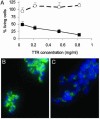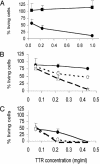Tissue damage in the amyloidoses: Transthyretin monomers and nonnative oligomers are the major cytotoxic species in tissue culture
- PMID: 14981241
- PMCID: PMC365703
- DOI: 10.1073/pnas.0400062101
Tissue damage in the amyloidoses: Transthyretin monomers and nonnative oligomers are the major cytotoxic species in tissue culture
Abstract
The transthyretin (TTR) amyloidoses are human diseases in which the misfolded TTR protein aggregates in tissues with subsequent visceral, peripheral, and autonomic nerve dysfunction. Recent reports have stressed the importance of oligomeric intermediates as major cytotoxic species in various forms of amyloidogenesis. We have examined the cytotoxic effects of several quaternary structural states of wild-type and variant TTR proteins on cells of neural lineage. TTR amyloid fibrils and soluble aggregates >100 kDa were not toxic. Incubation of TTR under the conditions of the cell assay and analysis by size-exclusion chromatography and SDS/PAGE reveal that monomeric TTR or relatively small, rapidly formed aggregates of a maximum size of six subunits were the major cytotoxic species. Small molecules that stabilize the native tetrameric state were shown to prevent toxicity. The studies are consistent with a model in which the misfolded TTR monomer rapidly aggregates to form transient low molecular mass assemblies (<100 kDa) that are highly cytotoxic in tissue culture.
Figures






References
-
- Buxbaum, J. N. & Tagoe, C. E. (2000) Annu. Rev. Med. 51, 543-569. - PubMed
-
- Merlini, G. & Bellotti, V. (2003) N. Engl. J. Med. 349, 583-596. - PubMed
-
- Sacchettini, J. C. & Kelly, J. W. (2002) Nat. Rev. Drug Discov. 1, 267-275. - PubMed
-
- Kelly, J. W. (1998) Curr. Opin. Struct. Biol. 8, 101-106. - PubMed
-
- Damas, A. M. & Saraiva, M. J. (2000) J. Struct. Biol. 130, 290-299. - PubMed
Publication types
MeSH terms
Substances
Grants and funding
LinkOut - more resources
Full Text Sources
Other Literature Sources
Medical
Research Materials
Miscellaneous

